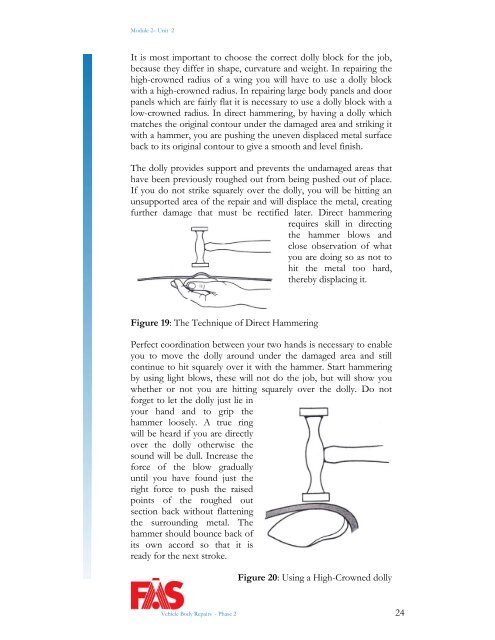TRADE OF VEHICLE BODY REPAIR - eCollege
TRADE OF VEHICLE BODY REPAIR - eCollege
TRADE OF VEHICLE BODY REPAIR - eCollege
You also want an ePaper? Increase the reach of your titles
YUMPU automatically turns print PDFs into web optimized ePapers that Google loves.
Module 2– Unit 2<br />
It is most important to choose the correct dolly block for the job,<br />
because they differ in shape, curvature and weight. In repairing the<br />
high-crowned radius of a wing you will have to use a dolly block<br />
with a high-crowned radius. In repairing large body panels and door<br />
panels which are fairly flat it is necessary to use a dolly block with a<br />
low-crowned radius. In direct hammering, by having a dolly which<br />
matches the original contour under the damaged area and striking it<br />
with a hammer, you are pushing the uneven displaced metal surface<br />
back to its original contour to give a smooth and level finish.<br />
The dolly provides support and prevents the undamaged areas that<br />
have been previously roughed out from being pushed out of place.<br />
If you do not strike squarely over the dolly, you will be hitting an<br />
unsupported area of the repair and will displace the metal, creating<br />
further damage that must be rectified later. Direct hammering<br />
requires skill in directing<br />
the hammer blows and<br />
close observation of what<br />
you are doing so as not to<br />
hit the metal too hard,<br />
thereby displacing it.<br />
Figure 19: The Technique of Direct Hammering<br />
Perfect coordination between your two hands is necessary to enable<br />
you to move the dolly around under the damaged area and still<br />
continue to hit squarely over it with the hammer. Start hammering<br />
by using light blows, these will not do the job, but will show you<br />
whether or not you are hitting squarely over the dolly. Do not<br />
forget to let the dolly just lie in<br />
your hand and to grip the<br />
hammer loosely. A true ring<br />
will be heard if you are directly<br />
over the dolly otherwise the<br />
sound will be dull. Increase the<br />
force of the blow gradually<br />
until you have found just the<br />
right force to push the raised<br />
points of the roughed out<br />
section back without flattening<br />
the surrounding metal. The<br />
hammer should bounce back of<br />
its own accord so that it is<br />
ready for the next stroke.<br />
Figure 20: Using a High-Crowned dolly<br />
Vehicle Body Repairs - Phase 2 24
















